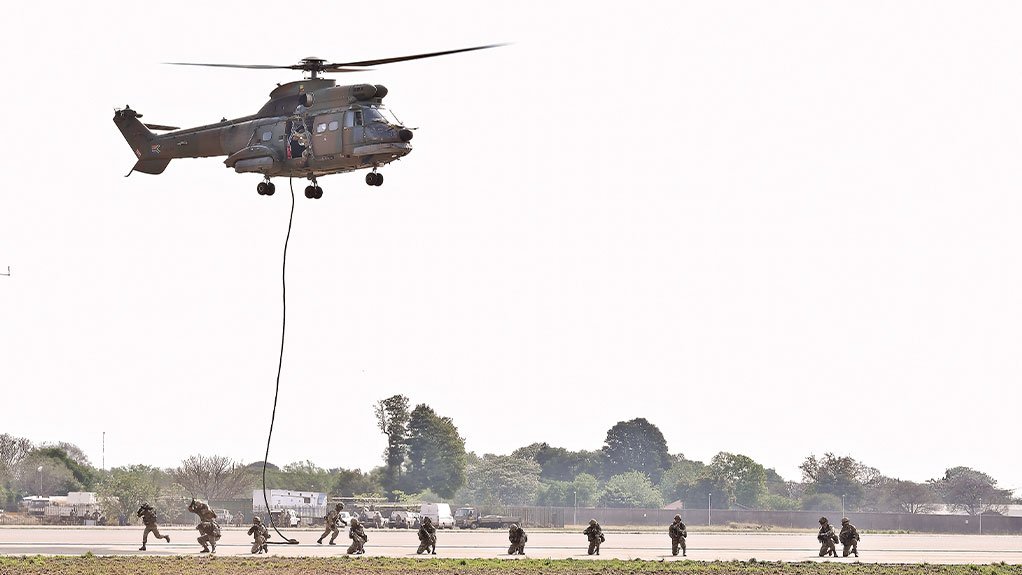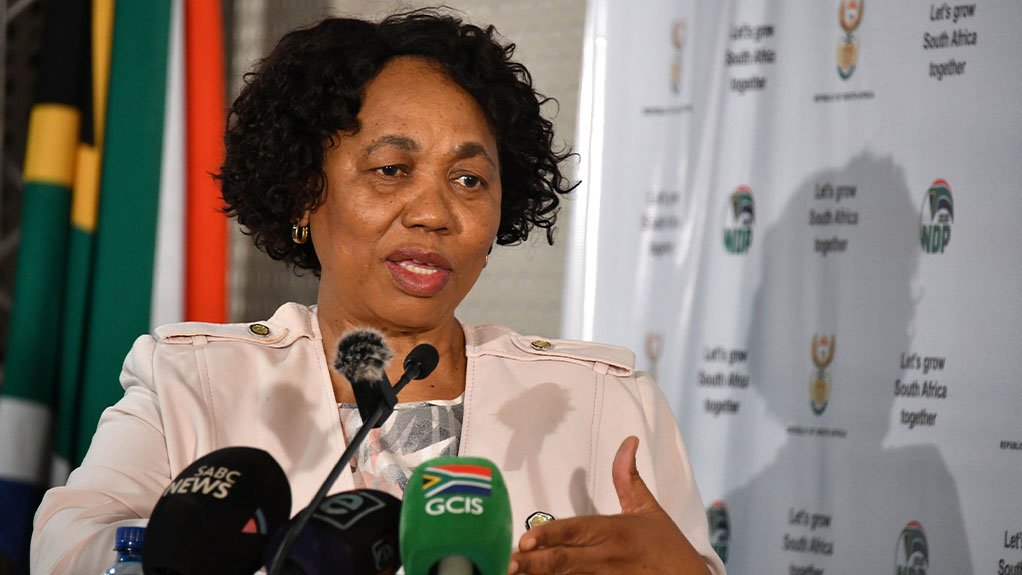What is the new Defence Minister to do about the SANDF?




QUICK REACTION: Troops rapid-rope down from an SAAF Oryx, is a capability the SANDF contingent in the DRC currently does not have
ANGIE MOTSHEKGA: The biggest dilemma facing the Minister is the lack of funding compared to the SANDF’s responsibilities
That the South African National Defence Force (SANDF) is badly underfunded, and is in a state that could reasonably be described as verging on crisis, is almost universally accepted among all those who are interested in the country’s defence capabilities and by the local aerospace and defence industries.
The Department of Defence (DoD), albeit hardly a disinterested party in the matter, has calculated that it is underfunded by 50%. (This estimate was made some years ago, baselined on the roles and missions that the SANDF was meant to do in 2011; given inflation and other factors, the underfunding could now be much worse, relative to the 2011 baseline.)
In mid-July, the new Parliamentary Portfolio Committee on Defence and Military Veterans released a statement, affirming that the proper funding of the SANDF was a matter of the “utmost urgency”. The committee highlighted that the SANDF was underfunded and suffered from limited logistical support. “The committee has identified several critical areas that need immediate attention and that effective collaboration is essential to address funding and operational requirements,” it stated.
Prior to that, in late June, South African Aerospace, Maritime and Defence Industries Association (AMD) CEO Sandile Ndlovu released an open letter to new Defence Minister Angie Motshekga.
“The SANDF is beset by challenges, including but not limited to, inadequate funding and training, outdated equipment, and severe operational limitations,” he wrote. “These issues have compromised our ability to protect South Africa’s territorial integrity and support State security services.”
South Africa currently spends 0.7% of its gross domestic product (GDP) on defence, which is, by international standards, very low. For comparison, in 2022 Kenya spent 2.3% of its GDP on defence, while the figure for Zambia was 1.2%, for Botswana 2.7%, Angola 1.3%, and Senegal 1.6%. Of the major sub-Saharan countries (Kenya, South Africa, Angola, Nigeria, and Senegal), the only one to spend less on defence than South Africa was Nigeria, at 0.6%. The average for the whole of sub-Saharan Africa was 1%, while the global average was 2.3%. (These are all World Bank figures.)
It is symptomatic of the parlous state of the SANDF today that, when its current deployment of 2 900 troops to the Democratic Republic of Congo (DRC), as part of the Southern African Development Community (SADC) Mission in the DRC (SAMIDRC), commenced, the mission was totally unfunded. (The National Treasury subsequently released funds to cover the SANDF contribution to the SAMIDRC, but it only released R2.1-billion, although the mission is estimated to have a cost of R2.6-billion.)
“The biggest dilemmas for Minister Motshekga are the lack of funding compared to the SANDF’s responsibilities, and ageing and unserviceable equipment,” points out specialist media website defenceWeb editor Guy Martin.
“This can be seen in Mozambique, where the SANDF withdrew alongside the SADC mission there prematurely and before the insurgency was contained, so it could focus on the SAMIDRC. The latter has not been very successful, and half-a-dozen South African soldiers have been killed in combat there since the beginning of the year. The South African contribution to the SAMIDRC has been hamstrung by a lack of logistical and air support – South African troops have no attack helicopters to support them, and have had to rely on expensive chartered [Illyushin] Il-76 [airlifters] to move troops and equipment. Compounding the situation in the DRC is the SANDF being tasked with Operation Corona border patrol duties as well as crime-fighting, maritime security, disaster relief and other tasks. It’s impossible for the SANDF to properly carry out all these missions with the funding it has.”
Troubleshooting
In Martin’s view, the Minister has either to get the defence budget increased, or reduce the SANDF’s responsibilities. Regarding the SANDF contribution to the SAMIDRC, this should be reinforced with South African Air Force (SAAF) aircraft, including Denel Rooivalk attack helicopters (for air support), Denel Oryx transport helicopters (for quick reaction and casualty evacuation) and Lockheed Martin C-130 Hercules airlifters, for logistical support. It should also receive mortar-locating radars and counter-fire systems, because rebel mortar attacks on SAMIDRC bases have already proven to be deadly.
Alternatively, the SANDF should be withdrawn from the SAMIDRC, in a manner that does not, if possible, embarrass South Africa. (Reinforcing the latter option is the uncertainty about whether the Rooivalk and Oryx self-defence systems would be able to handle modern man-portable surface-to-air missile systems, which the well-equipped and trained rebels might have access to.)
Another issue that needs addressing is the fact that South African soldiers are too old, with the average age of deployable troops being in the 40s, instead of the 20s. The SANDF needs to recruit more, and do so annually, while honourably and thoughtfully discharging older service members.
As for equipment, in most cases what the SANDF has is still effective, or can be upgraded to restore its effectiveness; currently, only a limited amount of new equipment is needed. The big current problem is low serviceability levels, due to lack of funding, but magnified by inefficiency and mismanagement in defence procurement agency Armscor and, regarding aircraft, the near collapse of State-owned defence industrial group Denel. Restoring the SANDF also requires restoring Armscor and Denel.
But, for the longer term, restoring the SANDF’s operational capabilities requires a clear concept of what its role is meant to be.
“You cannot really say much on what capabilities we should have (for example, strength, equipment types and numbers et al.) unless you set a level of national military capability,” stresses leading South African defence analyst Helmoed Heitman.
“The 1998 Defence Review force design would have enabled us to look after our immediate interests but no more than that. The 2015 Defence Review was based on having a regional intervention capability. The present budget really only provides for an enhanced border guard.”
“South Africa needs a clear and comprehensive national security strategy involving all stakeholders – political parties, civil society, and the private sector – to ensure a multi- dimensional approach to the country’s safety and security,” wrote Ndlovu in the AMD’s open letter. “Such a strategy would foster greater transparency, accountability, and public trust in the government’s ability to protect and advance national interests.”
“Contrary to what the generals might say, the SANDF’s tactics and strategies are outdated and not compatible with current combat environments,” argues specialist media website ProtectionWeb senior journalist Ricardo Teixeira. “A new doctrine must be informed by realistic vision and goals for the SANDF and will go hand-in-hand with a new force design. Together, these will inform what equipment is needed, and how many troops you need to use them, along with what they should be taught.”
Industrial Relations
Regarding the local defence industry, what should Motshekga’s priorities be?
“The Minister should go back to the Defence Review and the Defence Industry Strategy, which identify critical areas – maintenance, modernisation and upgrading of our equipment and systems, local manufacture of most munitions and high rate of use spares, secure communications and electronic warfare (EW),” highlights Heitman. “Further, ensure the survival of national maintenance, repair and overhaul capabilities, which should include the rejuvenation of the Navy Dockyard. Other focus areas should be Denel Aeronautics and Denel Landwards.”
Denel Landwards is the original-equipment manufacturer for all the SANDF’s vehicles (armoured as well as unarmoured), artillery, light weapons, and smaller-calibre ammunition. It, rather than Cuban mechanics, should be responsible for the refurbishment of SANDF vehicles and the government should support its own company (Denel Landwards is State-owned) by cancelling the contract with Cuba and awarding it to the local business. The survival of its light and medium ammunition producing business (branded PMP) must also be ensured, and its associated brass production capability retained.
Nor should the Minister’s focus be only on State-owned companies, he affirms. She should support private companies active in secure communications, such as Reutech and its suppliers, and in EW, such as Hensoldt South Africa and Sysdel, among others.
“A robust local manufacturing capability will bolster our overall defence capabilities, provide opportunities for job creation, skills development and advancement of our technological abilities,” wrote Ndlovu. “South Africa’s national interest is a delicate balance of competing priorities. We do believe that an investment in the sector can play a role in contributing to the relief of our country’s human security challenges. Our industry has the potential to contribute 3.5% to our GDP, which would make a meaningful contribution toward addressing our socioeconomic challenges.”
Currently, 95% of the weapons and equipment produced by the South African defence industry is exported. The industry’s exports are subject to the approval of the National Conventional Arms Control Committee (NCACC). And that is something that also needs to receive attention from the Minister.
“She needs to overhaul the NCACC, as it is holding the industry back and costing billions in lost sales,” explains Martin. “NCACC leadership is inept and is long overdue for replacement. The NCACC usually meets once a month to decide on export permit approvals; this is far too seldom and makes the export process too slow. To further speed up exports, certain countries and products should automatically be approved (green listed) rather than the case-by-case basis that stands at present.”
It is not that the NCACC denies some permits, it’s that it can go for years without making up its mind about a permit application. For example, in 2022 Poland placed an order with Germany’s Rheinmetall for some 50 000 artillery shells, which Rheinmetall subcontracted to its South African subsidiary, Rheinmetall Denel Munition.
The NCACC neither approved nor denied the required permit for some two years, finally resulting in Poland cancelling the order. The NCACC has reportedly also dithered about issuing (although the committee prefers to use the term ‘put on hold’) permits for contracts with Saudi Arabia, Turkey and the United Arab Emirates. The industry needs and wants either approval or denial. NCACC ineptitude also cost Denel a large contract that Oman wished to place with it.
The NCACC is meant to be transitioning from a paper-based system to an electronic system, but this process has been under way for years and shows little in the way of results. “Completely overhauling the NCACC and making it faster and more efficient would not only benefit the defence industry but the SANDF too, as industry would be in a better position to supply the SANDF,” affirms Martin.
The defence industry is not the only sector of the economy that directly and indirectly relies on the support of the SANDF. The aviation, shipping and fishing sectors do so as well. They rely on the SAAF and the South African Navy (SA Navy) for air and seaborne search and rescue (SAR), as well as recovery, in the event of accidents or disasters. South Africa’s zone of responsibility for oceanic SAR extends, westward, halfway to Brazil, southward, all the way to Antarctica, and eastward, halfway across the southern Indian Ocean, towards Australia.
Further, a series of South African Transport Ministers have signed treaties with other SADC countries, to provide them with SAR services over land and sea. But South Africa’s long-range air search capability has effectively disappeared, with the SAAF’s only surviving long- range platform, the C-130, having such a low serviceability rate that none would probably be available to respond to an emergency.
“The new Defence Minister and her team must ensure that the SAAF and the SA Navy have the capacity to fulfil South Africa’s extensive air and seaborne maritime SAR obligations,” urges local commercial aviation expert Linden Birns.
“Numerous trans-oceanic flights to and from South Africa take place every day on the understanding that South Africa is good for its promise to launch and sustain a coordinated SAR operation at the outer extremities of its zone of responsibility. If it is no longer possible for the SAAF and SA Navy to meet these obligations, then the Minister should advise her counterparts, the new Transport Minister and the new Minister of International Relations and Cooperation, so they can notify their counterparts in those countries with which South Africa has bilateral air services agreements, maritime and SAR agreements.”
Industry Proposal
“We are aware of the country’s strained budgets, and we have therefore proposed a private- public funding model,” pointed out Ndlovu. “This model aligns with the global trend of engaging the private sector in defence funding, allowing for innovation, efficiency, and sustainable military capabilities. It offers a pragmatic and immediate solution to our fiscal constraints; it provides for a payment plan that allows private companies to assume the financial responsibility for developing and delivering military systems and government paying for these systems over an extended period.”
Article Enquiry
Email Article
Save Article
Feedback
To advertise email advertising@creamermedia.co.za or click here
Comments
Press Office
Announcements
What's On
Subscribe to improve your user experience...
Option 1 (equivalent of R125 a month):
Receive a weekly copy of Creamer Media's Engineering News & Mining Weekly magazine
(print copy for those in South Africa and e-magazine for those outside of South Africa)
Receive daily email newsletters
Access to full search results
Access archive of magazine back copies
Access to Projects in Progress
Access to ONE Research Report of your choice in PDF format
Option 2 (equivalent of R375 a month):
All benefits from Option 1
PLUS
Access to Creamer Media's Research Channel Africa for ALL Research Reports, in PDF format, on various industrial and mining sectors
including Electricity; Water; Energy Transition; Hydrogen; Roads, Rail and Ports; Coal; Gold; Platinum; Battery Metals; etc.
Already a subscriber?
Forgotten your password?
Receive weekly copy of Creamer Media's Engineering News & Mining Weekly magazine (print copy for those in South Africa and e-magazine for those outside of South Africa)
➕
Recieve daily email newsletters
➕
Access to full search results
➕
Access archive of magazine back copies
➕
Access to Projects in Progress
➕
Access to ONE Research Report of your choice in PDF format
RESEARCH CHANNEL AFRICA
R4500 (equivalent of R375 a month)
SUBSCRIBEAll benefits from Option 1
➕
Access to Creamer Media's Research Channel Africa for ALL Research Reports on various industrial and mining sectors, in PDF format, including on:
Electricity
➕
Water
➕
Energy Transition
➕
Hydrogen
➕
Roads, Rail and Ports
➕
Coal
➕
Gold
➕
Platinum
➕
Battery Metals
➕
etc.
Receive all benefits from Option 1 or Option 2 delivered to numerous people at your company
➕
Multiple User names and Passwords for simultaneous log-ins
➕
Intranet integration access to all in your organisation



















